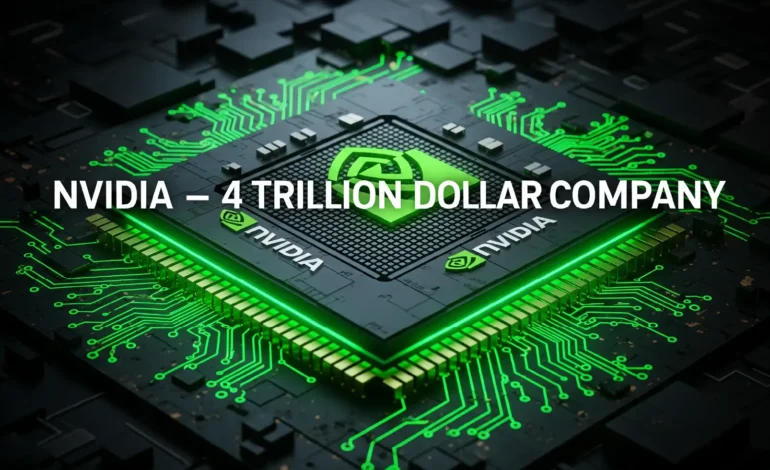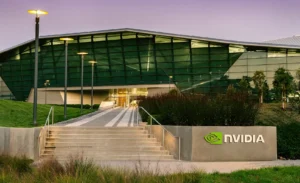Nvidia’s $4 Trillion Valuation: How AI Chips and a Visionary CEO Built the World’s Most Valuable Company

In the annals of corporate history, there are moments that define an era. Today, we are living through one of them. Nvidia, the company once known primarily by gamers for its graphics cards, has officially surpassed a market capitalization of $4 trillion, firmly establishing itself as the most valuable company on the planet. This isn’t just a financial headline; it’s the coronation of a new king in the tech world. Nvidia’s $4 Trillion Valuation marks a pivotal shift in the industry landscape.
But how did this happen? How did a chipmaker from Santa Clara race past software giants like Microsoft and consumer electronics titans like Apple? The story behind Nvidia’s $4 Trillion Valuation is not one of overnight success, but a multi-decade epic of relentless innovation, strategic foresight, and one of the boldest bets in technological history. Nvidia’s $4 Trillion Valuation is a testament to the power of vision and technology.
It’s a story driven by two core pillars: the absolute dominance of their AI hardware and the unwavering vision of their leather-clad CEO, Jensen Huang. Let’s break down how these elements combined to build a modern empire.

The Engine of Growth: More Than Just Silicon
At the heart of Nvidia’s dominance is a simple truth: if you want to run a powerful AI model, you almost certainly need their hardware. This near-monopoly wasn’t an accident.
1. The CUDA Moat: Over 15 years ago, Nvidia released CUDA, a software platform that allowed developers to unlock the power of their GPUs for general-purpose computing. While competitors focused on CPUs, Nvidia built a software ecosystem that has become the industry standard for AI research and development. This “CUDA moat” created a generation of developers who think and code in the Nvidia ecosystem, making a switch to a competitor incredibly difficult.
2. The AI Hardware Ladder: Nvidia didn’t just build one great chip. They created a relentless ladder of innovation. From the A100 to the H100 and now to the latest Blackwell and Rubin architectures, each generation of data center GPUs has delivered exponential performance gains. This constant evolution is a key factor behind Nvidia’s $4 Trillion Valuation, as it forces companies to continuously upgrade to stay competitive.
3. The Full-Stack Solution: Nvidia doesn’t just sell chips; it sells an entire AI data center in a box. With its Mellanox networking technology, DGX servers, and a vast library of software, Nvidia provides a complete, integrated solution. This full-stack approach makes it incredibly easy for customers to deploy AI at scale and locks them even deeper into the Nvidia ecosystem.

The Architect: The Vision of Jensen Huang
A company’s technology is only as good as the vision that guides it. For Nvidia, that vision comes directly from its co-founder and CEO, Jensen Huang. For decades, Huang has been a tireless evangelist for a future powered by accelerated computing and AI.
He famously bet the entire company on this vision long before the generative AI boom made it obvious. While others saw GPUs as a tool for better gaming graphics, Huang saw them as parallel processing engines capable of solving the world’s most complex problems. This conviction is arguably the single most important human element in the story of Nvidia’s $4 Trillion Valuation. His leadership has turned long-term, high-risk bets into a commanding market position, a story now covered by every major financial outlet from Bloomberg to the Wall Street Journal.
The Catalyst: The Generative AI Gold Rush
If Nvidia had built the perfect tools for a gold rush, the launch of ChatGPT in late 2022 was the moment someone screamed, “Gold!”
Suddenly, every major technology company on Earth—from Meta and Google to Amazon and Microsoft—needed to build or deploy massive Large Language Models (LLMs). And to do that, they needed tens of thousands of Nvidia’s high-performance GPUs. The insatiable demand created by the generative AI wave was the rocket fuel that propelled Nvidia’s stock into the stratosphere, turning a strong company into a global titan and solidifying Nvidia’s $4 Trillion Valuation.
What Does the $4 Trillion Milestone Mean?
Achieving this valuation is more than just a number; it signifies a fundamental shift in the tech landscape.
-
A New Tech Order: For the first time, the world’s most valuable company is not a consumer-facing software or device maker, but a deep-tech company that builds the underlying infrastructure. Power has shifted from the application layer to the silicon layer.
-
The AI Barometer: Nvidia’s $4 Trillion Valuation now acts as a barometer for the entire AI industry. Its performance is seen as a direct indicator of the health and growth of the artificial intelligence boom.
-
Challenges Ahead: While its position seems unassailable, Nvidia faces growing competition from rivals like AMD and Intel, as well as from its own customers who are developing in-house AI chips. Maintaining its edge will be its next great challenge.
Conclusion
Nvidia’s $4 Trillion Valuation is the culmination of a masterclass in business strategy. It was born from a visionary leader who made a bold, long-term bet on AI, backed by a brilliant engineering team that built an untouchable software and hardware ecosystem. They didn’t just create a product; as Jensen Huang has said, they created a new way of computing. You can learn more about their groundbreaking technology on Nvidia’s official website.
This milestone isn’t the end of the story. It is the beginning of a new chapter where artificial intelligence is the single most powerful force in technology, and for now, Nvidia is its undisputed king.
For more updates and deep dives into the technology that is shaping our world, continue to follow the analysis and news at techpastel.com.




